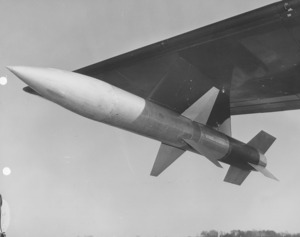| AAM-N-4 Oriole | |
|---|---|
 | |
| Type | Air-to-air missile |
| Place of origin |
|
| Service history | |
| In service | 1950-1955 |
| Used by | United States Navy |
| Production history | |
| Designed | 1947 |
| Manufacturer | Martin |
| Specifications | |
| Mass | 1,500 pounds (680 kg) |
| Length | 11 feet 7 inches (3.53 m) |
| Diameter | 11 inches (280 mm) |
|
| |
| Warhead | High explosive |
| Warhead weight | 25 pounds (11 kg) |
|
| |
| Wingspan | 3 ft 2.8 in (0.986 m) |
Operational range | 10 miles (16 km) |
| Flight altitude | Max at launch, 10 miles (16 km) |
| Maximum speed | Mach 2.5 |
Guidance system | Active radar homing |
The AAM-N-4 Oriole was an early American air-to-air missile, developed by the Glenn L. Martin Company for the United States Navy. Designed for launch from carrier-based aircraft, the missile programme was cancelled before flight testing began, and the missiles produced were utilized as test vehicles.
Design and development[]
Development of the AAM-N-4 Oriole began in 1947, when a development contract was awarded by the United States Navy's Bureau of Ordnance to the Glenn L. Martin Company to develop a heavy air-to-air missile,[1] utilizing active radar homing for fire and forget operation,[2] for launch from aircraft operating from aircraft carriers.[3] Oriole was intended to utilize a rocket[4] or rocket-ramjet propulsion system; the intended range of the weapon was 20 miles (32 km),[5] however as tested it was limited to a range of approximately 10 miles (16 km).[3] Ready for launch, the missile weighed 1,500 pounds (680 kg),[6] and used cruciform fins at the missile's midbody and at the tail for flight control.[7] Flight speed was originally intended to be above Mach 3.[8]
In 1948, the Oriole contract was redefined to be a guidance development program instead of a project to develop an operational missile; the program to construct test vehicles resumed in 1950 for research and development purposes,[9] the missiles being redesignated RTV-N-16.[3] Flight testing begain shortly thereafter at the Naval Air Missile Test Center at Point Mugu, California; testing continued through 1953, with 56 flight tests being conducted throughout the program;[9] as built the missile proved to be capable of Mach 2.5.[7] The Oriole program was terminated at the end of 1953.[10]
References[]
- Citations
- ↑ Gunston 1979, p.221.
- ↑ Friedman 1982, p.150.
- ↑ 3.0 3.1 3.2 Parsch 2005
- ↑ Haley 1959, p.130.
- ↑ Peck 1950, p.264.
- ↑ Bowman 1957, p.169.
- ↑ 7.0 7.1 Hemsch 1992, p.17.
- ↑ "Aircraft Armament, Part 2: Missiles and Projectiles". Flight International, 28 January 1955, p.118.
- ↑ 9.0 9.1 USPMTC 1989, p.52-53
- ↑ Fahey 1958, p. 32.
- Bibliography
- Bowman, Norman John (1957). The Handbook of Rockets and Guided Missiles. Chicago: Perastadion Press. ASIN B0007EC5N4.
- Fahey, James Charles (1958). The Ships and Aircraft of the U.S. Fleet (7th ed.). Washington, DC: Ships and Aircraft Publishers. ASIN B000XG6YU6. http://books.google.com/books?id=cGPJ9fJDJNIC&pg=PA32.
- Friedman, Norman (1982). U.S. Naval Weapons: every gun, missile, mine, and torpedo used by the U.S. Navy from 1883 to the present day. Annapolis, MD: Naval Institute Press. ISBN 978-0-87021-735-7.
- Gunston, Bill (1979). The Illustrated Encyclopedia of the World's Rockets and Missiles. London: Salamander. ISBN 978-0861010295.
- Haley, Andrew Gallagher (1959). Rocketry and Space Exploration. Princeton, NJ: D. Van Nostrand Company. ASIN B000GB0580.
- Hemsch, Michael (1992). Tactical Missile Aerodynamics: General Topics. Progress in Astronautics and Aeronautics. Reston, VA: American Institute of Aeronautics and Astronautics. ISBN 978-1563470158.
- Nichols, Gina (2011). The Navy at Point Mugu. Charleston, SC: Arcadia Publishing. ISBN 978-0-7385-7532-2.
- Parsch, Andreas (2005). "Martin AAM-N-4 Oriole". Directory of U.S. Military Rockets and Missiles Appendix 1: Early Missiles and Drones. designation-systems.net. http://www.designation-systems.net/dusrm/app1/aam-n-4.html. Retrieved 2013-01-21.
- Peck, James L.H.. "How Fast Can We Fight?". Chicago: Popular Mechanics Company. http://books.google.com/books?id=vSwDAAAAMBAJ&pg=RA1-PA144. Retrieved 2013-01-21.
- United States Navy Pacific Missile Test Center (1989). Days of Challenge, Years of Change: a Technical History of the Pacific Missile Test Center. Washington, CC: Government Printing Office. ASIN B000S75AFK.
| ||||||||||||||||||||||||||||||||||||||||||
The original article can be found at AAM-N-4 Oriole and the edit history here.